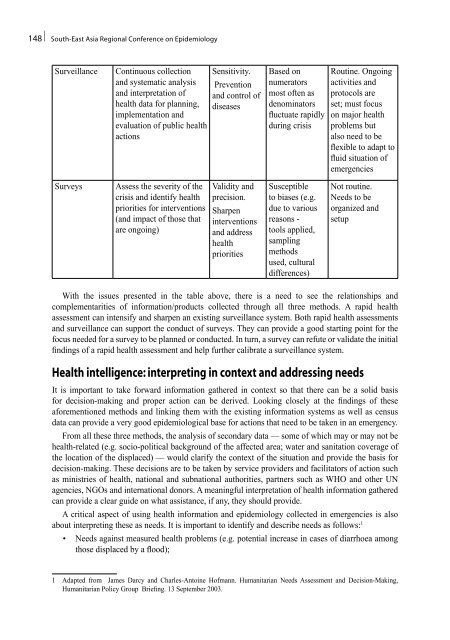South-East Asia Regional Conference on Epidemiology
South-East Asia Regional Conference on Epidemiology
South-East Asia Regional Conference on Epidemiology
You also want an ePaper? Increase the reach of your titles
YUMPU automatically turns print PDFs into web optimized ePapers that Google loves.
148 | <str<strong>on</strong>g>South</str<strong>on</strong>g>-<str<strong>on</strong>g>East</str<strong>on</strong>g> <str<strong>on</strong>g>Asia</str<strong>on</strong>g> <str<strong>on</strong>g>Regi<strong>on</strong>al</str<strong>on</strong>g> <str<strong>on</strong>g>C<strong>on</strong>ference</str<strong>on</strong>g> <strong>on</strong> <strong>Epidemiology</strong><br />
Surveillance C<strong>on</strong>tinuous collecti<strong>on</strong><br />
and systematic analysis<br />
and interpretati<strong>on</strong> of<br />
health data for planning,<br />
implementati<strong>on</strong> and<br />
evaluati<strong>on</strong> of public health<br />
acti<strong>on</strong>s<br />
Surveys Assess the severity of the<br />
crisis and identify health<br />
priorities for interventi<strong>on</strong>s<br />
(and impact of those that<br />
are <strong>on</strong>going)<br />
Sensitivity.<br />
Preventi<strong>on</strong><br />
and c<strong>on</strong>trol of<br />
diseases<br />
Validity and<br />
precisi<strong>on</strong>.<br />
Sharpen<br />
interventi<strong>on</strong>s<br />
and address<br />
health<br />
priorities<br />
Based <strong>on</strong><br />
numerators<br />
most often as<br />
denominators<br />
fluctuate rapidly<br />
during crisis<br />
Susceptible<br />
to biases (e.g.<br />
due to various<br />
reas<strong>on</strong>s -<br />
tools applied,<br />
sampling<br />
methods<br />
used, cultural<br />
differences)<br />
Routine. Ongoing<br />
activities and<br />
protocols are<br />
set; must focus<br />
<strong>on</strong> major health<br />
problems but<br />
also need to be<br />
flexible to adapt to<br />
fluid situati<strong>on</strong> of<br />
emergencies<br />
Not routine.<br />
Needs to be<br />
organized and<br />
setup<br />
With the issues presented in the table above, there is a need to see the relati<strong>on</strong>ships and<br />
complementarities of informati<strong>on</strong>/products collected through all three methods. A rapid health<br />
assessment can intensify and sharpen an existing surveillance system. Both rapid health assessments<br />
and surveillance can support the c<strong>on</strong>duct of surveys. They can provide a good starting point for the<br />
focus needed for a survey to be planned or c<strong>on</strong>ducted. In turn, a survey can refute or validate the initial<br />
findings of a rapid health assessment and help further calibrate a surveillance system.<br />
Health intelligence: interpreting in c<strong>on</strong>text and addressing needs<br />
It is important to take forward informati<strong>on</strong> gathered in c<strong>on</strong>text so that there can be a solid basis<br />
for decisi<strong>on</strong>-making and proper acti<strong>on</strong> can be derived. Looking closely at the findings of these<br />
aforementi<strong>on</strong>ed methods and linking them with the existing informati<strong>on</strong> systems as well as census<br />
data can provide a very good epidemiological base for acti<strong>on</strong>s that need to be taken in an emergency.<br />
From all these three methods, the analysis of sec<strong>on</strong>dary data — some of which may or may not be<br />
health-related (e.g. socio-political background of the affected area; water and sanitati<strong>on</strong> coverage of<br />
the locati<strong>on</strong> of the displaced) — would clarify the c<strong>on</strong>text of the situati<strong>on</strong> and provide the basis for<br />
decisi<strong>on</strong>-making. These decisi<strong>on</strong>s are to be taken by service providers and facilitators of acti<strong>on</strong> such<br />
as ministries of health, nati<strong>on</strong>al and subnati<strong>on</strong>al authorities, partners such as WHO and other UN<br />
agencies, NGOs and internati<strong>on</strong>al d<strong>on</strong>ors. A meaningful interpretati<strong>on</strong> of health informati<strong>on</strong> gathered<br />
can provide a clear guide <strong>on</strong> what assistance, if any, they should provide.<br />
A critical aspect of using health informati<strong>on</strong> and epidemiology collected in emergencies is also<br />
about interpreting these as needs. It is important to identify and describe needs as follows: 1<br />
• Needs against measured health problems (e.g. potential increase in cases of diarrhoea am<strong>on</strong>g<br />
those displaced by a flood);<br />
1 Adapted from James Darcy and Charles-Antoine Hofmann. Humanitarian Needs Assessment and Decisi<strong>on</strong>-Making,<br />
Humanitarian Policy Group Briefing. 13 September 2003.









